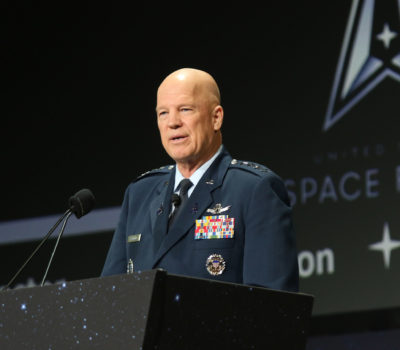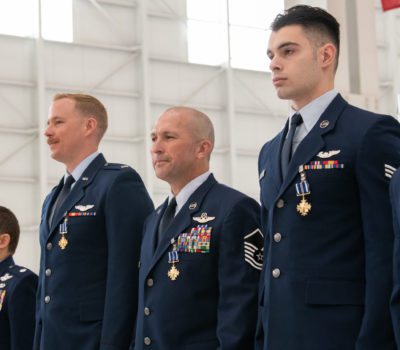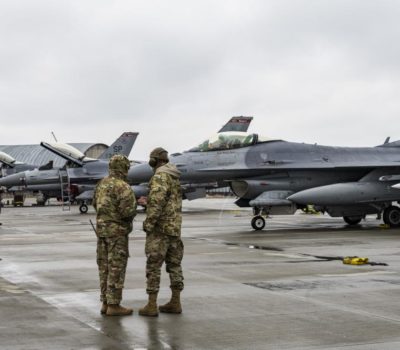US Must ‘Slash Costs’ to Afford Space Superiority, Raymond Says
US Space Command Formalizes Strategy to Buy More Commercial Satellite Services
C-17 Crew Who Saved 153 During Afghanistan Evacuation Awarded Distinguished Flying Cross
Milley Endorses More Permanent Bases in Europe—with a Slight Twist
Radar Sweep
US Hypersonic Missile Successful in Flight Test, DARPA Says
The US recently completed a successful “free flight” test of a hypersonic missile, according to the Pentagon, but reportedly kept the test quiet in an effort to avoid escalation with Russia over Ukraine. The Defense Advanced Research Projects Agency (DARPA) announced the test April 5, calling it the “second successful flight in DARPA’s HAWC [Hypersonic Air-breathing Weapon Concept] program.”
Biden Nominates Adm. Linda Fagan to Head Coast Guard, First Woman to Lead Military Service
The Biden administration has nominated Adm. Linda Fagan to lead the U.S. Coast Guard, a defense official told USNI News on April 5. Fagan, currently the Coast Guard’s vice commandant, will be the first woman to lead a U.S. military service. Fagan has been the Coast Guard’s number two since June and was the first woman in the service to be promoted to four stars.
Portland Air National Guard Unit Is First to Test Out Robot Dog for Base Security
The Portland Air National Guard's 142nd Security Forces Squadron became the first Guard unit in the nation to receive a new "robot dog" and plans to test the technology for surveillance and base security operations. The Oregon-based Guard unit's "Quad-legged Unmanned Ground Vehicle," otherwise known as the Q-UGV, can conduct video surveillance and patrol a fence line without putting Airmen in danger. Robot dogs first made an appearance at active-duty bases last year, and the equipment and testing are now trickling down to the Guard.
Paid Advertisement: Digitalization and the Future of Aerospace Program Productivity
"Digitalization is emerging as the crucial advantage that modern aerospace programs can turn to in the face of so much complexity. Quite simply, digitalization increases productivity by providing visibility into how specific requirements impact downstream engineering and manufacturing. This can be achieved by using a comprehensive digital twin and digital thread, which provide a robust understanding of aerospace and defense products and processes. Digital thread-based solutions enable multi-disciplinary processes and weaves relevant data together to present a rich, full view of product, production and process in a coherent, actionable manner," writes Dale Tutt, vice president of aerospace and defense industry at Siemens Digital Industries Software.
Commentary: Don’t Sleep on Russian Information-War Capabilities
“At the highest levels of government, world leaders have nearly unanimously come out in support of Ukraine, even hurling a tsunami of sanctions at Russia. On the other end of the spectrum, blue-and-yellow flags now dot American neighborhoods as symbols of solidarity for Ukraine. From this vantage point, Ukraine looks to have Russia beat. But this is only part of the story. Instead of fixating on Russia’s missteps, policymakers and analysts would benefit from studying Ukraine’s sophisticated information campaign while bearing in mind that Russia retains significant information warfare capabilities and a willingness to use them,” Alyssa Demus and Christopher Paul, who both study information warfare, influence, and other defense operations in the information environment at the nonprofit, nonpartisan RAND Corporation.
Boeing’s New Air Force One Hit by Production Mishaps
Boeing Co. factory problems disrupted production of one of its new Air Force One planes earlier this year, adding to the manufacturer’s stumbles developing the U.S. presidential jets, people familiar with the matter said. The production mishaps, which involved a pair of attempts to place one of the two of jets under development onto jacks, risked damaging the aircraft whose development is already behind schedule, these people said.
PODCAST: Ukraine Update and the FY23 DOD Budget Release
In Episode 70 of the Aerospace Advantage podcast, AFA’s Mitchell Institute for Aerospace Studies team gathers to discuss air and space topics that you’ve seen in the national security headlines. The conversation begins with a discussion on the ongoing conflict in Ukraine, then moves to initial take-aways from the fiscal 2023 budget submission that recently went to Congress. With the Air Force set to divest 150 aircraft, including a number of F-22s, and reduce the F-35 buy rate, there is much to discuss on this front.
The Air Force Plans To Test-Launch A Mysterious New Air-To-Air Missile
The previously unknown Modular Advanced Missile is the latest addition to a growing collection of in-development air dominance missiles.
Reports: Attacks On Space Capabilities Rising As Predicted
Predictions about an increase in attacks on space capabilities made over the last five years are proving true, say a pair of new reports issued by Washington, D.C.-based think tanks April 4. The Center for Strategic and International Studies (CSIS) and the Secure World Foundation (SWF) both issued annual studies assessing space threats. But this year, the authors contend, past predictions are aligning with new evidence of incidents.
Double Helicopter Crash at Fort Stewart was ‘Not an Accident’
An incident involving two Army helicopters that killed a medical evacuation pilot at a Fort Stewart, Georgia, airfield last week was not an accident and is under criminal investigation, Army Times has learned. Capt. James Bellew died March 30 at about 2 a.m. in an “incident” involving two HH-60 Black Hawk helicopters at Wright Army Airfield, a dual-use airport between Fort Stewart and the city of Hinesville.
Inside the Air Force’s Secret Mission to Lift Half a Ton of Enriched Uranium Out of Kazakhstan
“We were sitting there in the cockpit, writing Tom Clancy novels in our heads about what would happen if we had to go down."





